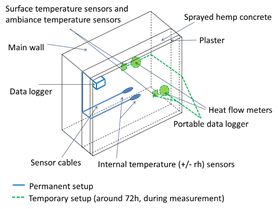Laboratory investigation of hygrothermal monitoring of hemp-concrete walls
DOI:
https://doi.org/10.21809/rilemtechlett.2017.36Keywords:
hemp concrete, instrumentation, thermal transmittanceAbstract
In the global will of reducing fossil energy consumption and greenhouse gas emission in the building sector, the use of bio-based insulating materials is gaining interest thanks to their profitable properties and their suitability for the renovation of ancient buildings made out of unconventional materials. However, such materials are still lacking of characterization, and more precisely of on-site evaluation, as no complete measurement protocol is available. The starting point to fill this gap would be to set-up a protocol for whole building instrumentation, and this paper is investigating questions arisen in that goal, and more precisely regarding the impact of sensor locations on the assessment of key parameters. For that purpose, instrumented polystyrene and hemp concrete wallets of dimensions 0.9 × 0.9 × 0.1 m3 with well-known thermal and hydric characteristics are tested within a double climatic chamber. The impact of temperature sensor locations and implementations are tested through indirect estimation of the thermal conductivities of the materials composing the wallets. The effect of the hygrothermal processes on the measurement of thermal performance is also investigated through the analysis of the wall global transmittance. These results finally allow to provide some recommendations concerning the on-site instrumentation of hemp concrete walls.

Downloads
Published
How to Cite
Issue
Section
License
Authors retain copyright of the articles published in RILEM Technical Letters and grant the journal the right of first publication with open access. The work is simultaneously licensed under Creative Commons Attribution 4.0 International License (CC BY 4.0) that allows others to share and adapt the work under the following terms: 1) a proper attribution is given in a form of bibliographic record with the DOI link directing to RILEM Technical Letters; 2) a link to the license is provided; 3) the changes (if any) are indicated.









